Good, modern-day cowboy-action shooters can push lead out of lever-action rifles at about 10 shots in two seconds. That’s fast. Tuned guns help. SASS (Single Action Shooting Society) rules allow only original or replica centerfire lever- or slide-action rifles that reflect the period between 1860 and 1899. Caliber can be the minimum, 32, to the largest, 45. Rifles must have exposed hammers, tubular magazines, and barrel lengths longer than 16 inches to qualify for matches. That means clones of the Winchester Model 1866, Models 1873, and Model 1892, are contenders, as well as the Marlin 1894 and reproductions of the Colt Lightning. Many competitors run reloaded 38 Special to the minimum velocity. SASS rules require rifle ammunition to have a maximum muzzle velocity of 1,400 fps or less. The 38 Special has other attributes that make it popular, such as mild recoil, less cost, and ease of reloading.

For this test, we acquired three rifles that fire the 38 Special cartridge:
- Cimarron Model 1866 Yellow Boy Short Rifle
- Taylor’s & Co. Model 1873 Comanchero
- Uberti Model 1873 Competition
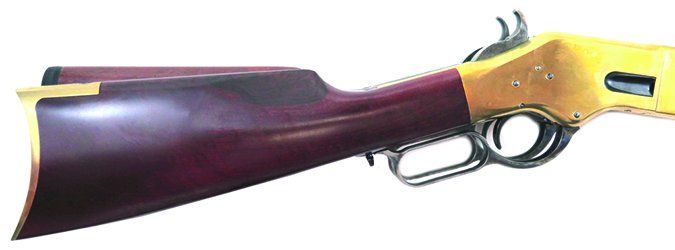
The Taylor’s and Uberti are also chambered in 357 Magnum, so they could be used for hunting small- to medium-size game. The Taylor’s and Uberti also have factory action jobs on them to enhance their performance in competition; specifically, they both have short-stroke levers that allow the user to manipulate the lever faster than the standard Model 1873. We choose the Cimarron 1866 to see if the factory-tuned option made the rifle easier to use. In our opinion, it does. The lever-locking latch, which holds the lever in place, seems unneeded with these rifles since they are so new, but with use, the lever will loosen and have some play.
Both the 1866 and 1873 models use a toggle link mechanism that is operated by the shooter via the lever. To load, cartridges are pushed through the loading gate and into a magazine tube that keeps the cartridges under spring tension in the carrier block. When the lever is pushed forward to eject an empty case, the carrier block is raised up with a fresh cartridge. At the same time the firing-pin extension cocks back the hammer. When the lever is moved back, the fresh round is chambered, the carrier returns down, and the magazine-tube follower pushes the next fresh cartridge into the carrier. On short-stroke rifles such as the Uberti and Taylor’s, the arc of the lever is shortened, so, in theory and practice, the shorter the stroke, the faster the rifle can be fired.
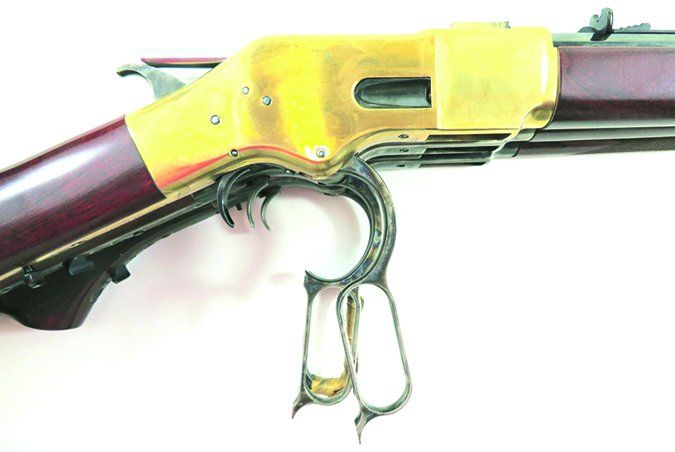
While the 1873 is perhaps the most popular rifle model used in competition, the ‘66 also has a following. There are substantial differences in the designs between the 1873 and 1866 models. They use different receivers, and the 1866 lacks a safety device that requires the user to bring the lever fully rearward to fire the rifle. In operation, the 1866 and 1873 are identical. Another difference in the models are their stock drops. The 1873 has less drop than the 1866. Another obvious difference is the 1866 lacks a dust cover. The Model 1873 rifles corrected this because the open actions on the ’66 and Henry rifles allowed dust and dirt to accumulate in the action. Dust covers on 1873 models cleans this up. We suggest you try each before you buy to understand what model rifle is better suited to your stature and shooting style.
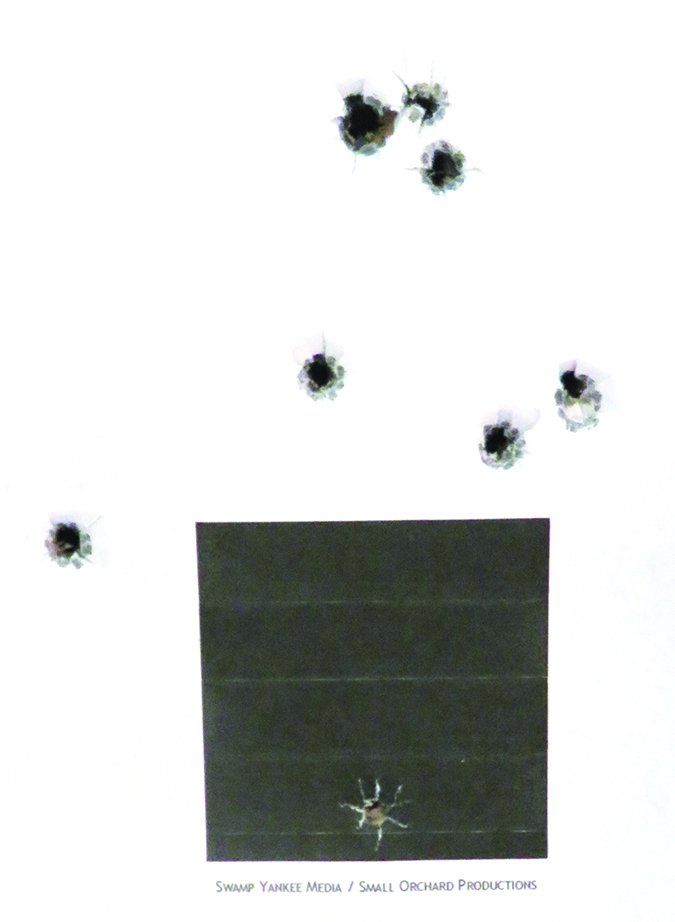
All three models tested here have 10-round magazines and octagonal 20-inch barrels. The heavier octagonal barrel gives the rifles heft and helps reduce recoil when shooting fast so the competitor stays on target better. We agree the heavier barrels are an asset when levering and shooting these rifles fast. At nearly 8 pounds unloaded, these rifles are heavy yet feel lively in hand for fast, deliberate point shooting.
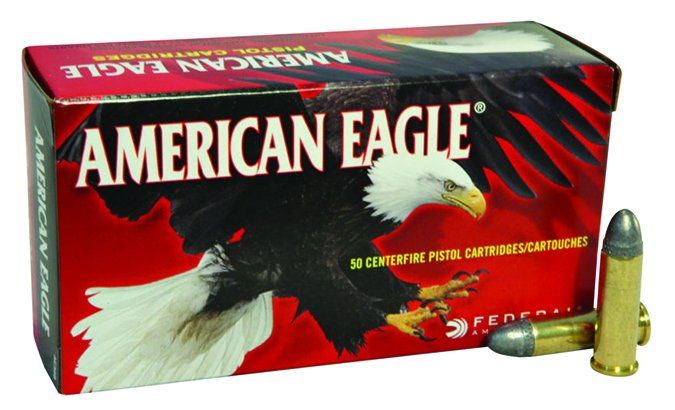
We wanted to see if factory-tuned rifles were worth the extra cost and if these made-for-fast-shooting replicas were just that — fast shooters. We also looked for ease of use and comfort since shooting 60 rifle rounds is the average rifle round count during a match. Manipulating a lever fast can be rough on hands. The easier the lever is to operate, the faster the follow-up shot and the easier it is to stay on target. Ease of loading is another factor. The Uberti was a breeze to load. We busted our thumbs on the Cimarron. Though these rifles are sold under different names, they were all manufactured by Uberti for Taylor’s and Cimarron.
Lever Action Rifle Range Data
| American Eagle 38 Special 158-gr. LRN | Taylor’s & Company 1873 Comanchero Rifle | Uberti 1873 Competition | Cimarron 1866 Yellow Boy Short Rifle |
| Average velocity | 1009 fps | 974 fps | 1013 fps |
| Muzzle energy | 357 ft.-lbs. | 333 ft.-lbs. | 360 ft.-lbs. |
| Smallest group | 1.52 in. | 1.72 in. | 1.92 in. |
| Average group | 1.77 in. | 1.92 in. | 1.97 in. |
| Armscor 38 Special 158-gr. FMJ | |||
| Average velocity | 993 fps | 911 fps | 979 fps |
| Muzzle energy | 346 ft.-lbs. | 291 ft.-lbs. | 336 ft.-lbs. |
| Smallest group | 1.72 in. | 1.8 in. | 0.92 in. |
| Average group | 1.92 in. | 2.31 in. | 1.32 in. |
| PMC 38 Special 158-gr. LRN | |||
| Average velocity | 1054 fps | 939 fps | 1056 fps |
| Muzzle energy | 390 ft.-lbs. | 309 ft.-lbs. | 391 ft.-lbs. |
| Smallest group | 1.56 in. | 1.77 in. | 1.82 in. |
| Average group | 1.78 in. | 1.93 in. | 1.97 in. |
| Blazer Brass 357 Magnum 158-gr. JHP | |||
| Average velocity | 1137 fps | 973 fps | – |
| Muzzle energy | 454 ft.-lbs. | 332 ft.-lbs. | – |
| Smallest group | 1.92 in. | 0.92 in. | – |
| Average group | 1.97 in. | 1.02 in. | – |
| To collect accuracy data, we fired five-shot groups from a bench using a rest. Distance: 50 yards with open sights. We recorded velocities using a ProChrono digital chronograph set 10 feet from the muzzle. | |||
How We Tested
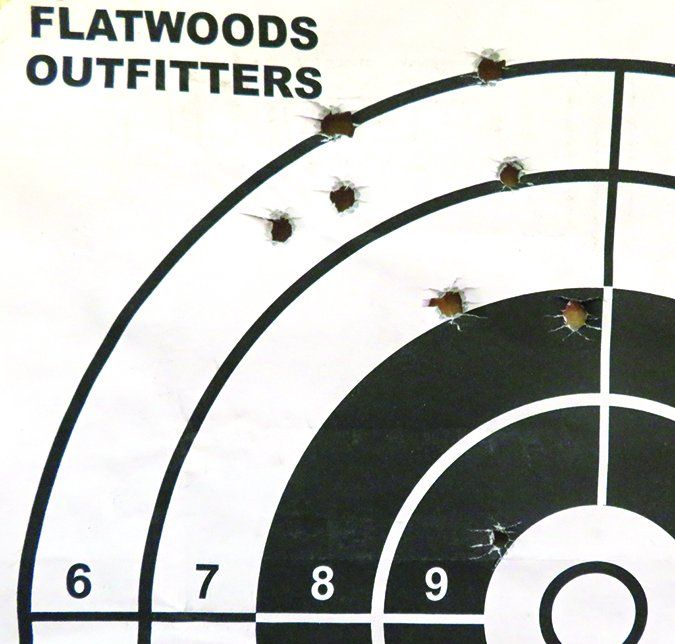
We sourced 38 Special ammo from American Eagle with 158-grain LRN bullets, Armscor with a 158-grain FMJ, PMC with a 158-grain LRN, and Blazer Brass loaded with a 158-grain JHP.
We tested for accuracy using a rest at targets set at 50 yards. Though the maximum distance for cowboy action shooting is 25 yards — except for certain side matches — minimum distance to targets is 13 yards in a match. Also, the minimum rifle-size target is 16 by 16 inches. We also tested for speed at 15 yards using Caldwell Orange Peel targets with a 5.5-inch bullseye. From a low-ready position, we fired five rounds as fast as possible while trying to keep hits on the target. We tested standing and sitting. Note that these are top-ejecting rifles and the force with which you manipulate the lever decides whether the empty case ends up bouncing off your head or over your shoulder. Lesson: Don’t baby the levers on these rifles. When the smoke at the range had cleared, this is what we discovered:
Cimarron 1866 Yellow Boy Short Rifle Model CA221 38 Special, $1012
GUN TESTS GRADE: B+
The Yellow Boy Short Rifle is a beautiful long arm that is suited for competition and nostalgic plinking. The sights and trigger were serviceable. The action and loading were stiff, but they break in with use.

| ACTION TYPE | Lever |
| OVERALL LENGTH | 39.5 in. |
| HEIGHT | 7.7 in. |
| WIDTH | 1.3 in. |
| WEIGHT UNBOXED/UNLOADED | 7.5 lbs. |
| WEIGHT AS TESTED/LOADED | 9.3 lbs. |
| BARREL LENGTH/TWIST | 20 in.; 1:18.5 RH |
| BARREL FINISH | Blued |
| RECEIVER FINISH/MATERIAL | Brass |
| BUTTSTOCK/FOREND | Oiled satin-finish walnut, smooth |
| STOCK BUTTPAD | Brass, crescent shape |
| STOCK LENGTH OF PULL | 13 in. |
| TRIGGER PULL WEIGHT | 6.6 lbs. |
| TRIGGER STYLE | Single stage |
| SAFETY | None |
| MAGAZINE | 10-round tube |
| REAR SIGHT | Adjustable buckhorn |
| FRONT SIGHT | Dovetailed gold bead |
| WARRANTY | 5 year |
| TELEPHONE | (877) 749-4861 |
| WEBSITE | Cimarron-Firearms.com |
| MADE IN | Italy |
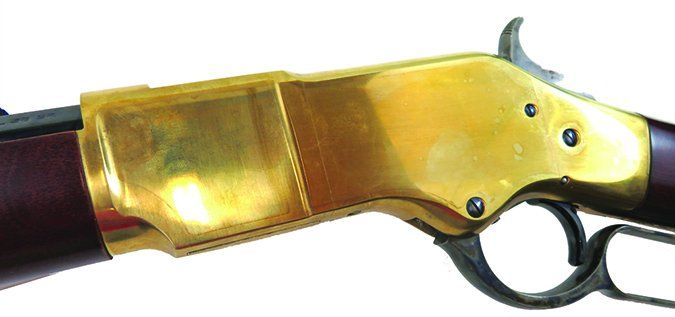
The 1866 Yellow Boy Short Rifle is a replica of the Winchester Model 1866 rifle, called the “Yellow Boy” due to the brass receiver. It was also the first Winchester rifle. The Cimarron is an excellent facsimile, with deep blued barrel, case-hardened lever and hammer, bright brass receiver and smooth walnut stock and forend. This rifle looked great straight out of the plain cardboard box. Fit and finish were excellent. The wood was oiled and smooth. The buttplate was crescent shaped like on original rifles. The end cap on the forend was also brass.
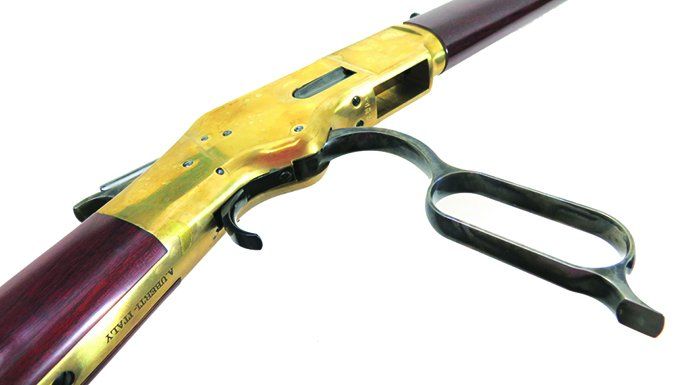
The rear semi-buckhorn sight is adjustable for elevation via a stepped ladder, and windage is adjustable via a brass punch and hammer. The front sight was a plain black blade on a base that was dovetailed into the barrel and held in place with a set screw. If you wanted, you could easily replace the front sight with a white-bead or brass-bead blade, which we would do.
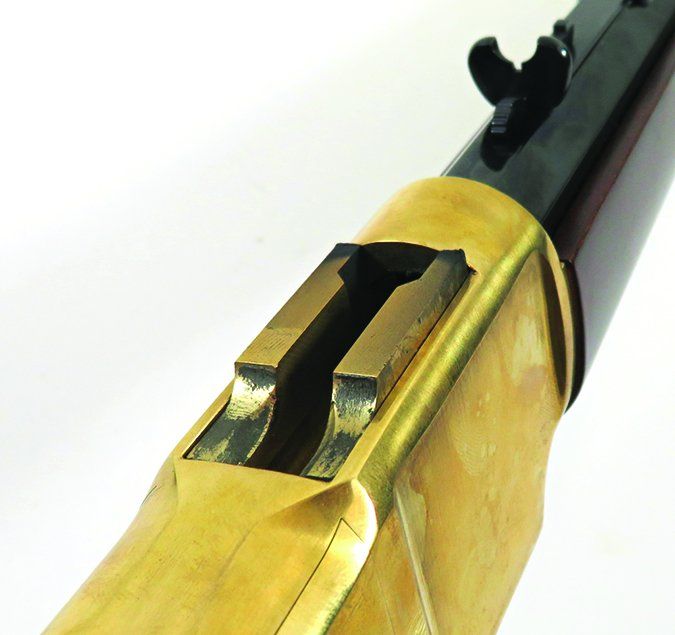
In hand, the Cimarron is lively and comes to the shoulder with ease. The stock drops at a steeper angle than the Model ’73 rifles. Testers were split on which stock was better. In our opinion, it is a personal preference based on your neck length and where the gun sits vertically on the shoulder.
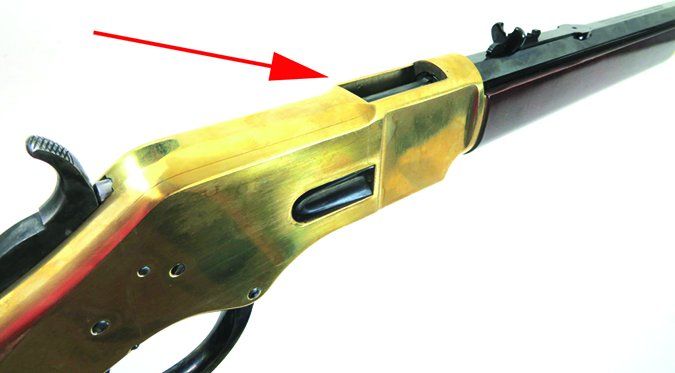
Where we noticed a difference in the Cimarron compared to the Uberti and Taylor’s was in the action. The Yellow Boy’s action was stiff like a new pair of blue jeans. Eventually they break in, but it takes time. We worked the lever vigorously prior to heading to the range to smooth out any burrs. At the range, we found loading the last two cartridges was difficult. We busted our thumbs topping off the Yellow Boy.
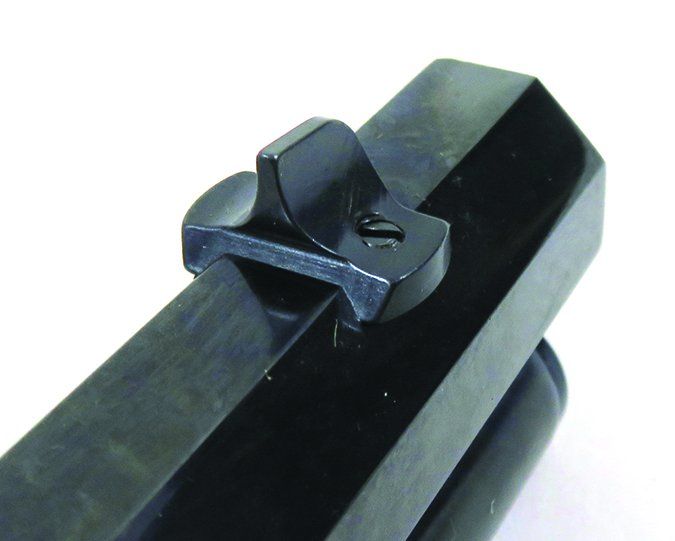
We also experienced the lever working very stiffly the first time. In fact we had to gorilla the lever to chamber a round. We worked the lever as if we were confronting a bad actor in a B-movie action flick. We got the lever to work, and it became easier to manipulate with use. In the beginning, it seemed when the magazine tube was fully topped off, we had to work the lever more vigorously to ensure we did not short-stroke the rifle. Short-stroking means when the shooter manipulates a firearm and fails to chamber a round, with the subsequent failure to fire. Do not get this confused with the short-stroke levers on the Uberti and Taylor’s.
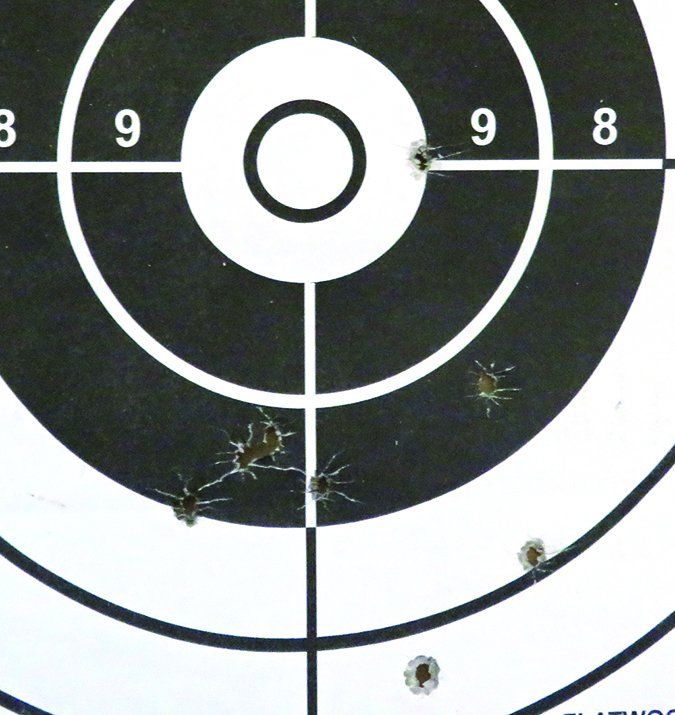
By the fifth magazine tube on the ’66, we began to break in the Yellow Boy and found manipulating the lever was easier, but we still had to pay attention to push the lever fully forward to clear the chamber, load a fresh round, and get off the shot. After a lot of use, our testers said the Yellow Boy’s action became slicker than the Uberti action but not as slick as the Taylor’s mechanism.
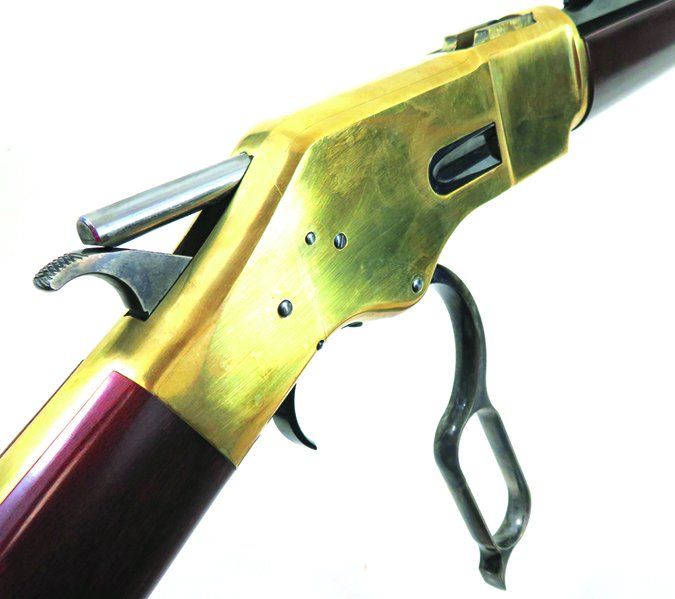
Because the Yellow Boy uses a brass frame, 357 Magnum ammunition cannot be used in the rifle. If you fancy chasing whitetails or wild pigs, the 357 Magnum makes a better hunting round. This isn’t a deal killer, just a reflection of rifle design. We did notice the muzzle velocity of the Cimarron was higher than the Uberti and similar to the Taylor’s. With Armscor 158-grain FMJ ammo, we shot a best five-shot group that measured 0.92 inches.
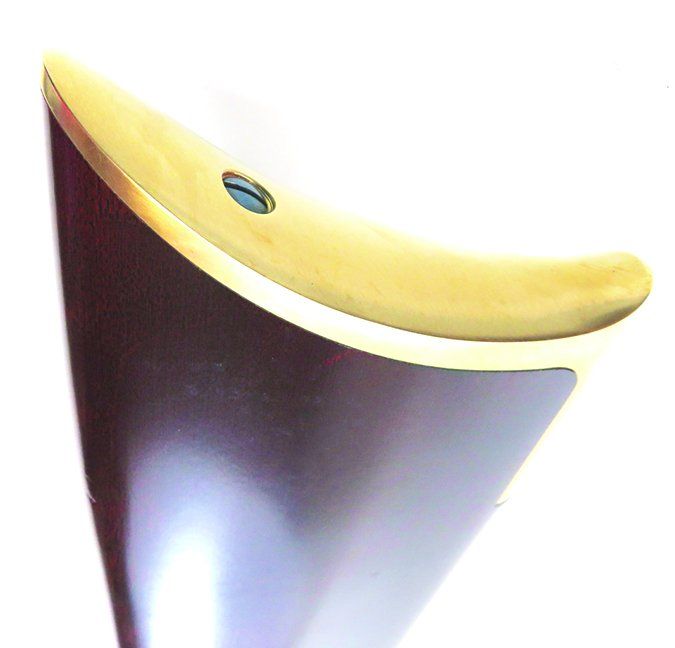
Pretty impressive at 50 yards and with open sights. The trigger was a bit heavy, so we were surprised at the results when we tabulated the data. Though the crescent-shape buttplate was slick, it helped center your shoulder on the butt. For speed shooting, the stiff action and trigger did not allow us to perform as well as with the other rifles. There was no take-up with the trigger, and it broke at a heavy 6.6 pounds. Our five-shot speed groups averaged between 6.5 and 7 inches. Still plenty good for cowboy competition, but not good enough for us.
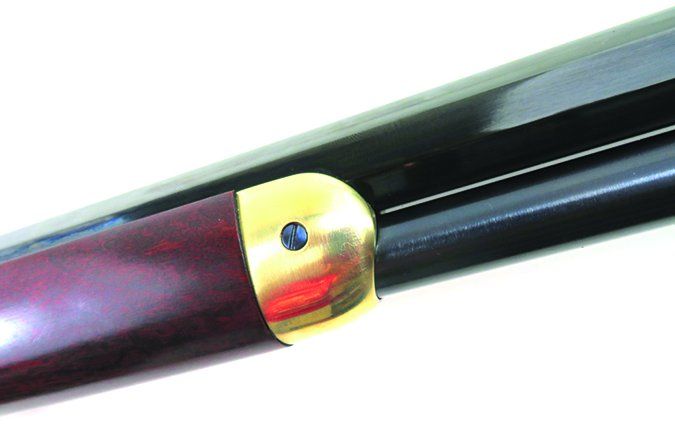
Our Team Said: The Cimarron was capable, and we liked it, but be aware that it will need to be broken it. An action job would most likely cost about $200, which would bring the price of the Yellow Boy more in line with the other rifles tested. If you want a period plinker, we think the Cimarron is right on. If you want to up your cowboy-action shooting skills, we’d definitely opt for an action job.
Taylor’s & Company 1873 Comanchero Rifle Model 2043COM 357 Magnum, $1496
GUN TESTS GRADE: A
The Comanchero looks period correct yet offers a faster lever than the standard Model ’73, plus it was fast when we pushed it and accurate when we were taking our time.

| ACTION TYPE | Lever |
| OVERALL LENGTH | 38.8 in. |
| HEIGHT UNBOXED | 7.7 in. |
| WIDTH | 1.3 in. |
| WEIGHT UNBOXED/UNLOADED | 7.5 lbs. |
| WEIGHT AS TESTED/LOADED | 9.3 lbs. |
| BARREL LENGTH/TWIST | 20 in.; 1:18.5 RH |
| BARREL FINISH | Blued |
| RECEIVER FINISH/MATERIAL | Case-hardened steel |
| BUTTSTOCK/FOREND | Oiled satin finish walnut, checkered |
| STOCK BUTTPAD | Steel, crescent shape, leather butt cover |
| STOCK LENGTH OF PULL | 13 in. |
| TRIGGER PULL WEIGHT | 2.4 lbs. |
| TRIGGER STYLE | Single stage |
| SAFETY | Lever pin |
| MAGAZINE | 10-round tube |
| SIGHTS | Adjustable buckhorn rear; dovetailed gold bead front |
| WARRANTY | 1 year |
| TELEPHONE | (540) 722-2017 |
| WEBSITE | TaylorsFirearms.com |
| MADE IN | Italy |
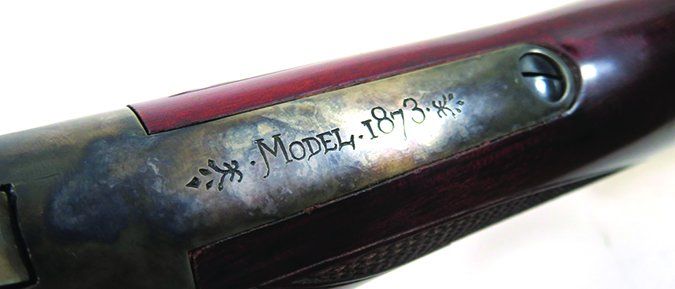
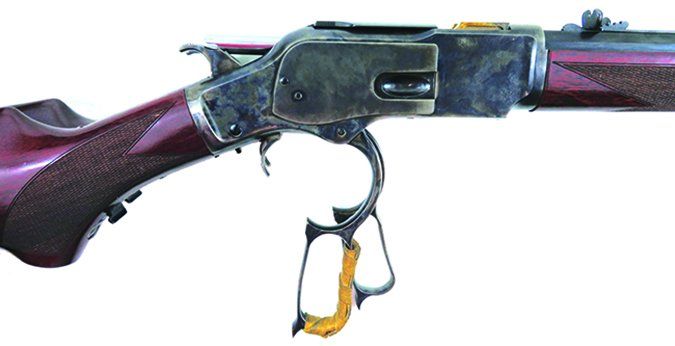
Taylor’s 1873 Comanchero does an excellent job at creating a competition-ready rifle that performs while looking like a rifle from the late 19th century. The Taylor’s Comanchero has a pistol-grip stock, so the loop is slightly curved to match the stock. Some testers felt the curved grip was not as comfortable to lever, but due to the slickness of the Comanchero’s action, there was less force against your knuckles.
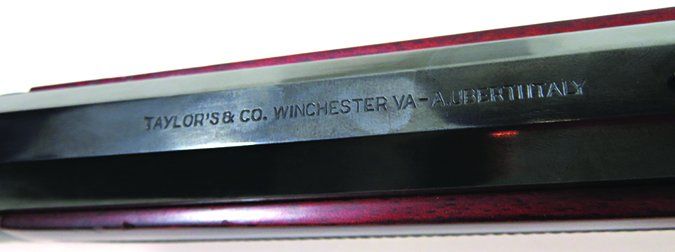
The Taylor’s had excellent wood-to-metal fit. The receiver, lever, and hammer were a rich case-hardened blue, while the barrel and magazine tube were deeply blued. The walnut stock had an oil finish and was checkered at the pistol grip and the forend. We appreciated the checkered forend in particular, because on the days we tested it, the weather was humid and our hands were sweaty.
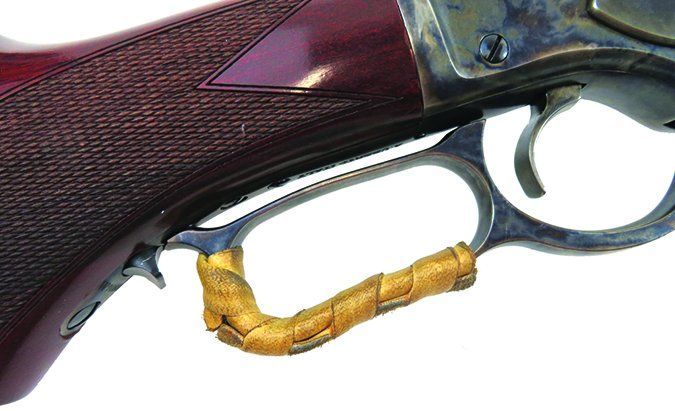
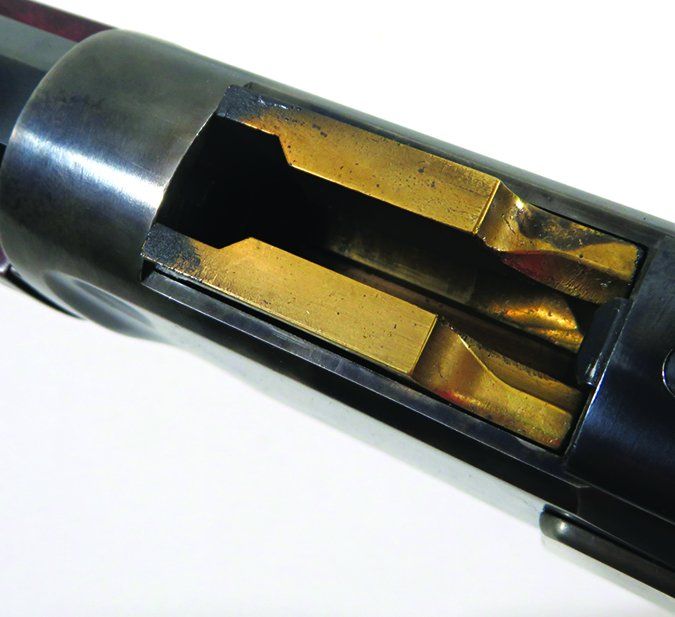
We would add brass tacks to the forend of the Uberti and Cimarron for better gripping traction and to remind us where to grasp the rifle for a more consistent grip. We did note that a tiny bit of checkering did chip off during testing. Some of that will happen with vigorous use, but dabbing a brown permanent marker on the spot will reduce its visibility.
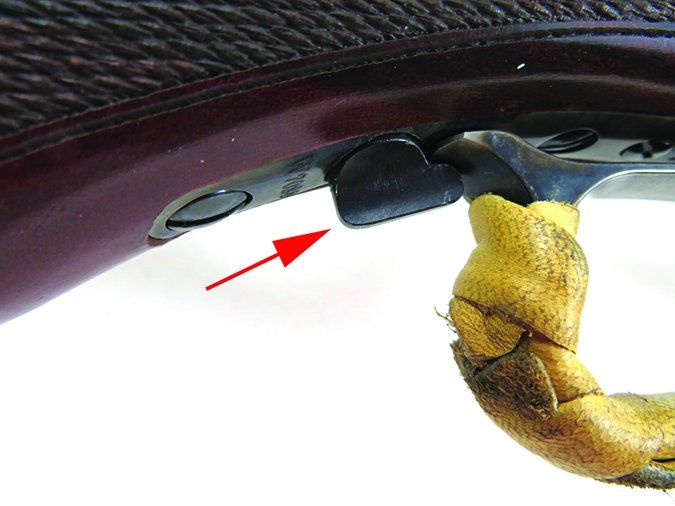
The crescent buttplate was covered in a soft piece of buckskin leather stitched together that offers a soft cheek weld and also helped absorb some of the felt recoil, especially with the magnum loads. The lever was also outfitted with a piece of leather stitched onto the bottom part of the loop. The lever on the loop helped make the lever easier to use for some testers, but we felt the straight-lever loops were more comfortable.
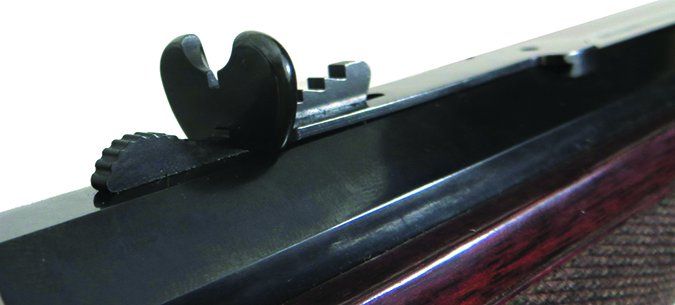
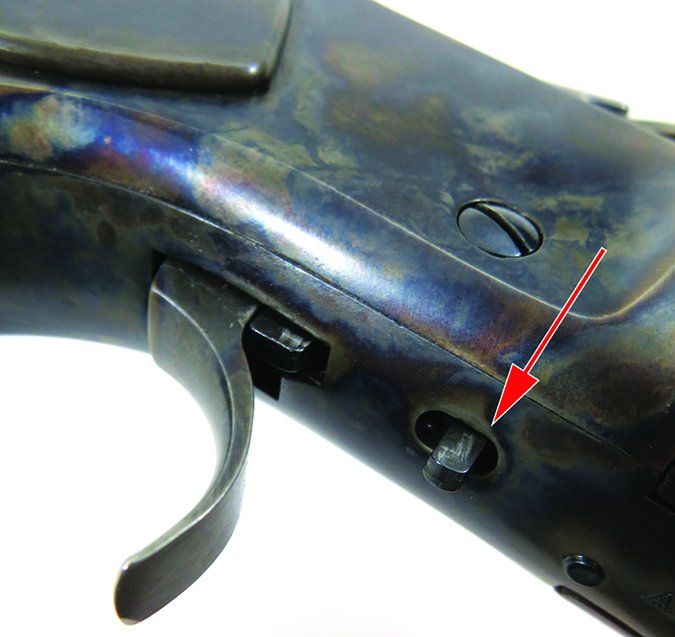
Like the Uberti, the Taylor’s featured a short-stroke lever that allowed the user to more quickly cycle the rifle. The action on the Comanchero was the slickest of the three rifles tested. It also had the best trigger, and it used a lighter safety system spring, so there was no short-stroking. Not one tester short-stroked the Comanchero, while the other two rifles did see a few short strokes and missed shots.
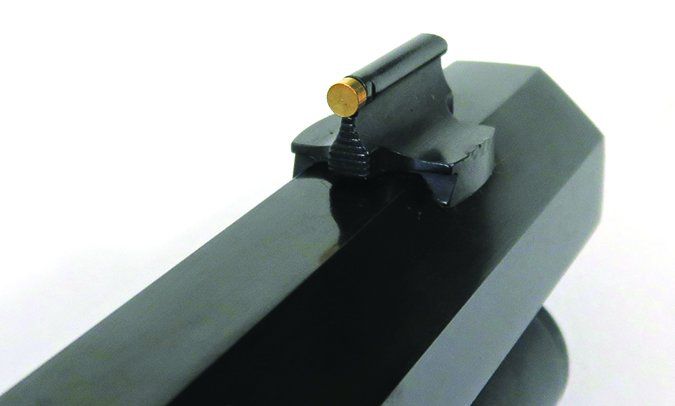
The rear semi-buckhorn sight is adjustable for windage and elevation, and the front-sight blade had a brass bead. We felt the sights on the Uberti and Taylor’s were superior to the sights on the Cimarron.
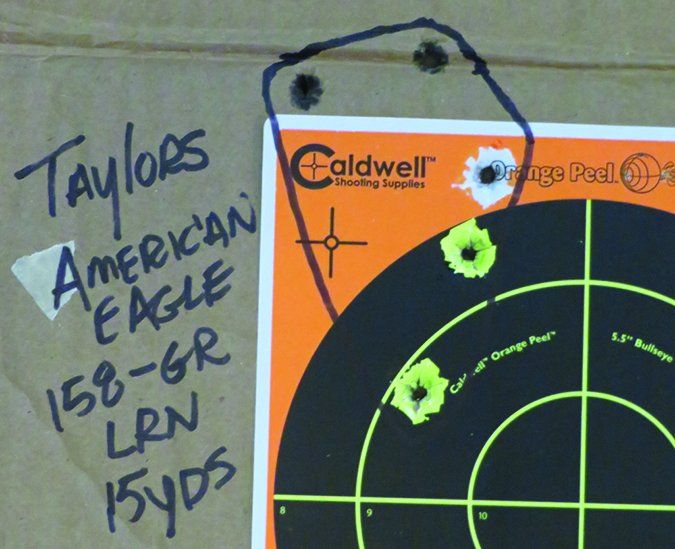
In accuracy testing, we clustered holes at 50 yards. The data showed the Comanchero was the most accurate of the rifles tested. Our best five-shot group was fired with American Eagle 158-grain LRN bullets. That’s larger than the best groups fired from the other rifles, but in the aggregate, the Taylor’s pulled ahead. There was some take-up with the trigger, but it broke at a crisp 2.4 pounds.
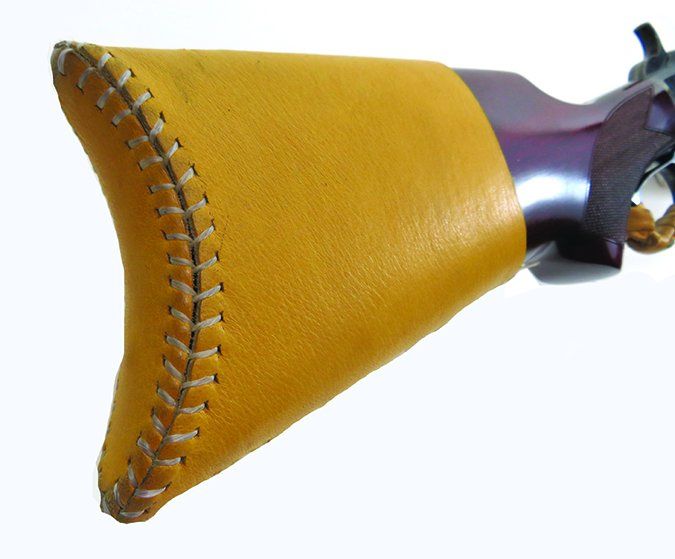
In the fast-shooting stage of testing, the Comanchero shined. At 15 yards, our best five-shot group measured 3.15 inches, which was the tightest of all the fast-fire groups. The combination of the sights, slick action, and crisp trigger contributed to this positive outcome. We found we could shoot the Comanchero better and faster than the other rifles.
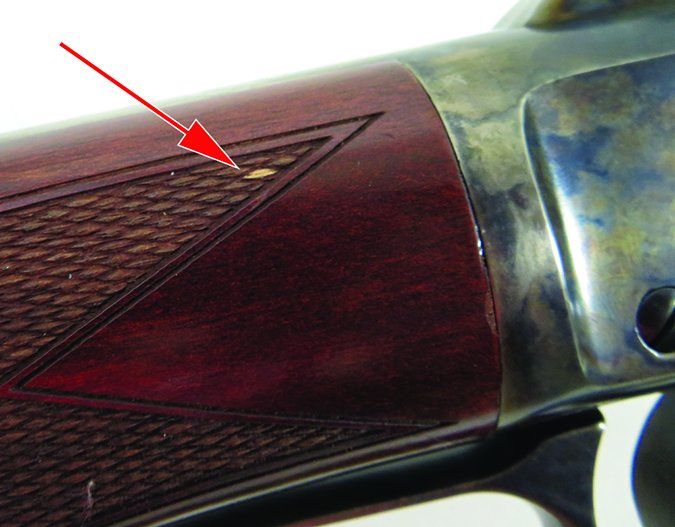
Our Team Said: The Comanchero was the most expensive, but it delivered the performance and features you would want in a competition-ready rifle. The action was slick, the trigger was crisp, and the sights were excellent. Plus, it looked like a period-piece, even though it was tricked out for modern-day cowboy-action shooting.
Uberti 1873 Competition Model 342905 357 Magnum, $1249
GUN TESTS GRADE: B+
The Uberti was the easiest to load to capacity and had a nice, crisp trigger. The flat shotgun-style buttplate was fast to the shoulder. We liked the sights. The lever was stiff on the rear stroke, and the safety system spring was too stiff. We expected a bit more for a rifle marketed as an 1873 Competition rifle.

| ACTION TYPE | Lever |
| OVERALL LENGTH | 39 in. |
| HEIGHT UNBOXED | 7.7 in. |
| WIDTH | 1.3 in. |
| WEIGHT UNBOXED/UNLOADED | 8 lbs. |
| WEIGHT AS TESTED/LOADED | 9.8 lbs. |
| BARREL LENGTH/TWIST | 20 in.; 1:18.75 RH |
| BARREL FINISH/MATERIAL | Blued steel |
| RECEIVER FINISH/MATERIAL | Case-hardened steel |
| BUTT STOCK/FOREND | Oiled satin-finish walnut, smooth |
| STOCK BUTTPAD | Rubber, flat |
| STOCK LENGTH OF PULL | 13.5 in. |
| TRIGGER PULL WEIGHT | 3.6 lbs. |
| TRIGGER STYLE | Single stage |
| SAFETY | Lever pin |
| MAGAZINE | 10-round tube |
| REAR SIGHT | Adjustable buckhorn |
| FRONT SIGHT | Dovetailed gold bead |
| WARRANTY | 5 year |
| TELEPHONE | (800) 264-4962 |
| WEBSITE | Uberti-USA.com |
| MADE IN | Italy |
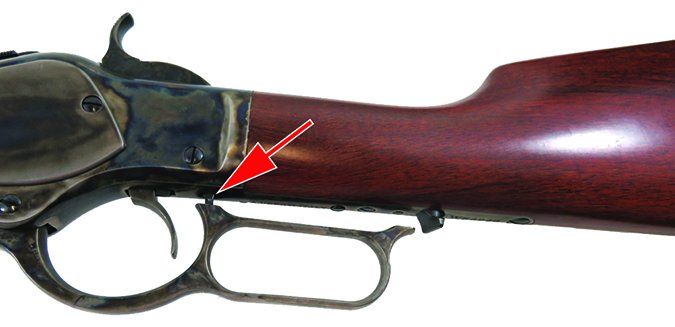
The 1873 Competition was the least traditional of the rifles tested due to the rubber recoil pad. Some testers liked it; others didn’t. The rubber recoil pad was flat, not curved like the other butts, so it came up to the shoulder fast and did help with recoil, especially when shooting 357 magnum loads. The stock is a straight grip like on the Yellow Boy. The Taylor’s was a pistol grip style. The rubber buttpad also increased the LOP by half an inch.
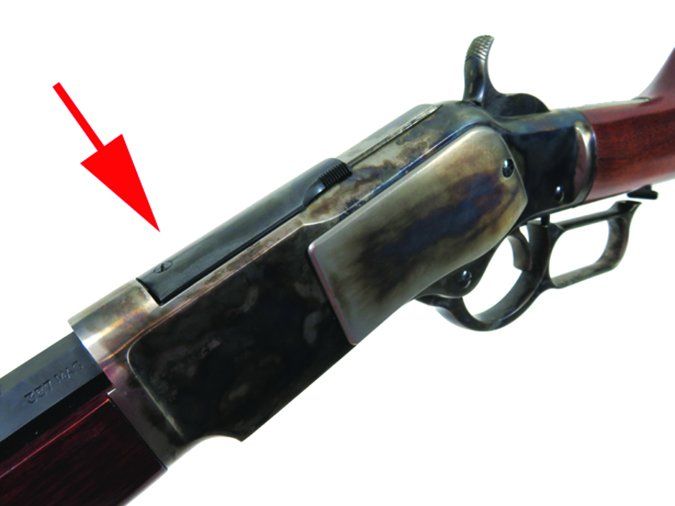
We did appreciate the rubber recoil pad because it helped mitigate recoil, especially with 357 Magnum ammunition. The rubber also adhered to the shoulder. Uberti makes the 1873 Competition to fill a need for a Model 1873 that is competition ready, and for the most part, the company has succeeded. While the fit and finish of the rifle was good, the action is enhanced so it operates more smoothly than a standard ’73, and it includes a short-stroke lever to decrease the time between shots.
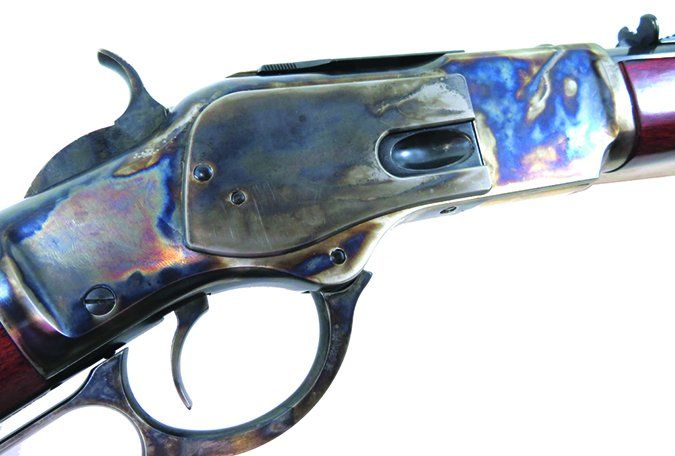
The Competition has a case-hardened receiver, lever, and hammer, while the barrel and magazine tube are deeply blued. The oil-finish smooth stock is fitted well. This is an all-business ’73 made to excel in competition. The semi-buckhorn rear sight is adjustable for elevation via a ladder and windage via a brass punch and hammer. The front sight is dovetailed into the barrel, and the blade sports a brass bead, which makes aiming the sights easier than the black sights of the Cimarron. The bright brass dot shows up well on dark targets. A set screw holds the front sight base in place.
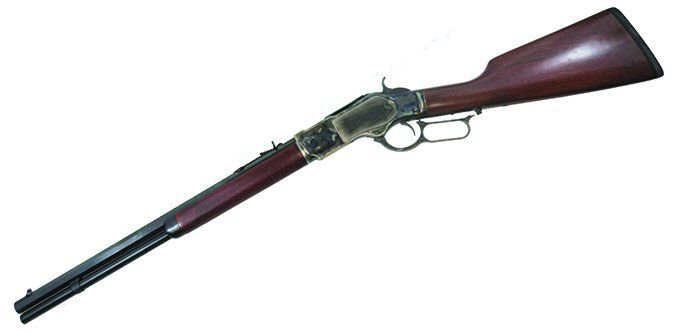
Both the Uberti and Taylor’s rifles have a safety system that requires the lever to be squeezed fully flush to the frame to fire the rifle. A small spring that makes the safety tab protrude was very stiff on the Uberti, and it caused a few testers to short-stroke the lever and not be able to fire a shot. Some competitors replace the spring with a lighter spring so it is easier to disengage the safety. The testers who had issues soon learned to squeeze the lever fully home before firing.

We also noticed on the closing stroke of the lever there was a bit more resistance compared to the Taylor’s and Cimarron. We feel that if you are going to manufacture a competition rifle, these details should be addressed at the factory. The trigger was crisp and light, but the safety lever required the user to squeeze the lever loop to the stock to fire the rifle, which distracted us from squeezing the trigger.
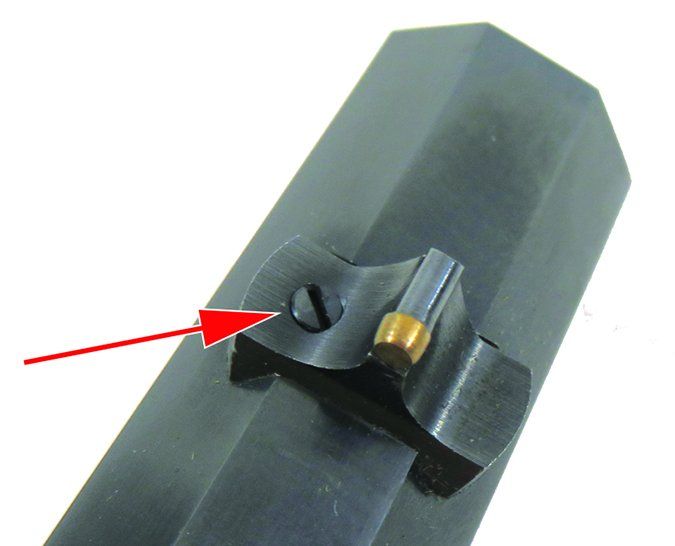
As we collected range data, we found the muzzle velocity of the Competition was noticeably less than the other two rifles. The Blazer Brass 357 Magnums loaded with a 158-grain JHP gave us a best five-shot group of 0.92 inches. We noticed the Uberti lagged behind in accuracy with the 38 Special ammunition.
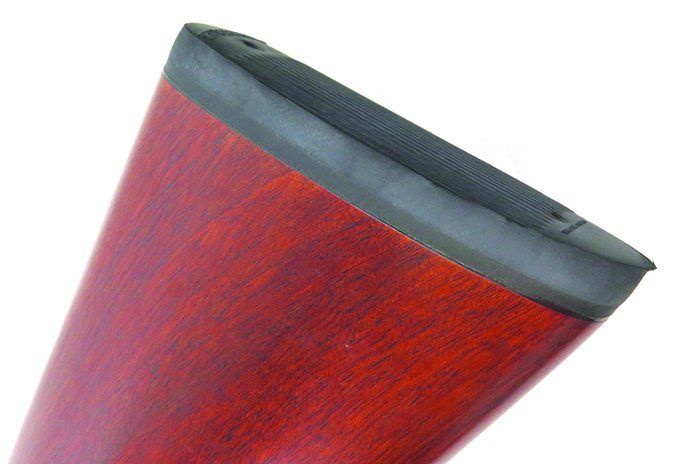
The Uberti was fast to target and with a follow-up shot. In fast fire at 15 yards, our five-shot groups measured 5 inches. The Uberti came in second to the Taylor’s in speed due to the Uberti’s heavy safety system lever. We also felt the straight loops of the Uberti and Cimarron were more comfortable to lever fast. The Taylor’s had a curved loop that was not as comfortable.
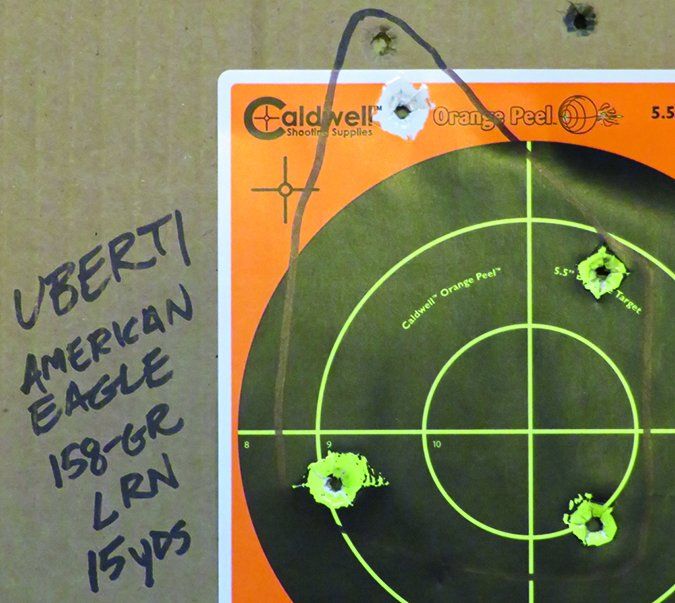
Our Team Said: We liked the Competition for its ability to shoulder fast. While it is not traditional looking, it makes shooting the rifle easier and more comfortable. The action was not as slick as we expected, nor was the safety system competition-friendly. This rifle needed a bit more work to be a true competition rifle.
Written and photographed by Robert Sadowski, using evaluations from Gun Tests team testers.
















